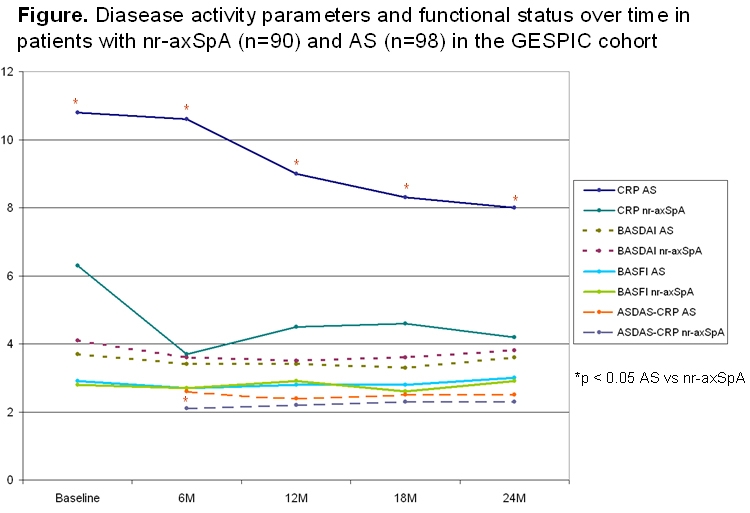Session Information
Session Type: Abstract Submissions (ACR)
Background/Purpose In cross-sectional studies it has been demonstrated that non-radiographic axial spondyloarthritis (nr-axSpA) does not differ from ankylosing spondylitis (AS) with respect to clinical signs of disease activity. Prospective studies comparing clinical course of the disease over time are, however, lacking. The purpose of this analysis was to investigate the clinical course of the disease over two years in patients with nr-axSpA in comparison to AS.
Methods In total, 210 patients with early axSpA (115 with AS according to the modified New York criteria and symptom duration ≤10 years, and 95 with nr-axSpA and symptom duration ≤5 years) with complete radiographic data over 2 years from the German Spondyloarthritis Inception Cohort (GESPIC) were included. Clinical assessment, which included standard disease activity (BASDAI, C-reactive protein – CRP), function (BASFI) and spinal mobility (BASMI) assessments, as well as therapy recording, was performed at baseline and every 6 months thereafter. Starting from the visit at month 6, the ASDAS-CRP and the ASAS NSAID intake score were calculated.
Results The majority of patients were included in GESPIC and followed-up prior to marketing authorisation of TNF blockers for AS and nr-axSpA. However, 17 AS patients (14.8%) and 5 nr-axSpA patients (5.3%) received at least one prescription of a TNF blocker during 2 years of follow-up and were excluded from the further analysis. Remaining patients with nr-axSpA (n=90) did not differ from AS patients (n=98) with respect to the BASDAI and the BASFI at any time point during 2 years of follow-up (figure). AS patients had however significantly higher level of CRP at all time points but ASDAS-CRP was significantly higher in AS at 6M only (figure).
There were also no substantial differences in the treatment between two groups. Spinal mobility (as measured by BASMI) was generally better in nr-axSpA as compared to AS, but this difference was statistically significant only at two time points (6 and 12 months).
Among all patients who did not receive a TNF-Blocker during 2 years of follow-up, 10 patients with nr-axSpA and 22 patients with AS had at baseline BASDAI≥4 and elevated CRP. Low disease activity state at at least 2 time points during 2 years of the follow-up as defined by BASDAI<4 was achieved by 57% of nr-axSpA and by 40% of AS patients, BASDAI<4 and normal CRP by 25% and 13%, BASDAI≤2 by 13% and 13%, and ASDAS inactive disease by 25% and 0% of nr-axSpA and AS patients, respectively. All differences were statistically non-significant.
Conclusion Patients with nr-axSpA and AS demonstrated the same course of the disease over 2 years as evaluated by the level of symptoms, functional status and NSAIDs treatment (except anti-TNF). Only a small proportion of patients with nr-axSpA and AS reached a stricter definition of low disease activity over two years of follow-up without TNF-blocker treatment.
Disclosure:
D. Poddubnyy,
None;
H. Haibel,
None;
J. Braun,
None;
M. Rudwaleit,
None;
J. Sieper,
None.
« Back to 2014 ACR/ARHP Annual Meeting
ACR Meeting Abstracts - https://acrabstracts.org/abstract/patients-with-non-radiographic-axial-spondyloarthritis-and-ankylosing-spondylitis-demonstrate-the-same-clinical-disease-course-over-two-years-results-from-the-gespic-cohort/

